Don't wanna be here? Send us removal request.
Link
During recent Trump’s visit to India, both the countries signed US 3 billion dollars defence deal involving various sophisticated weapons. The deal consists of the sale of six Boeing AH-64E Apache Guardian attack helicopters for the Indian Army and 24 Sikorsky MH-60R Sea Hawk multi-role helicopters for the Indian Navy.
Pakistan has already shown concerns that this deal would result in further destabilizing the already volatile region.
Pakistan’s Foreign Ministry’s Spokeswoman Aisha Farooqui stated that “the sale of such sophisticated weapons to India will disturb the strategic balance in South Asia with security implications for Pakistan and the region.” She also stated that the region could not afford an arms race or conflict and urged the international community to prevent the destabilization of the region.
Since 2007 India’s defence cooperation with the US has reached US 17 billion dollars as it aims to modernize its military to achieve its ultimate goal of becoming the global power. With the recent purchase of the sophisticated weapons, India is increasing its sphere of influence in the region which is quite alarming for its neighboring countries specifically Pakistan. The defence agreement between them clearly marks close collaboration in military, conventional and non-conventional weapons which may pose serious repercussion on geo-strategic scenarios of South Asia.
US being the major power is supporting India to play a larger role of the regional policeman and fulfill its long term hegemonic designs to dominate the smaller states with the help of its military strength. Hence this defence cooperation has accelerated India’s dream of becoming the global power.
Moreover India’s obsession of buying the most sophisticated weapons is a serious concern for Pakistan as it is likely to create conventional asymmetry in the region. The recent deal consist of weapons which Pakistan doesn’t have right now, hence it will disturb the conventional balance between the two states. Maritime security cooperation between India and the US is nothing but an attempt to secure the maritime domain which can cause serious maritime conflict between India and Pakistan in the Indian Ocean and international seas as well.
The Apache attack helicopters are equipped with the hellfire missiles, night vision capabilities, 70 mm rockets and an automatic gun, which makes it the most lethal machine in the world. The Apache would add greater firepower and agility to the Indian ground forces for any quick and intense operations against Pakistan.
This Indo-US deal has the potential to undermine the Pakistan’s strategy of minimum credible deterrence. Hence this cooperation can have disastrous effects on the stability of the region by tilting the strategic balance between in favor of India. Pakistan should convey to the US at the highest level, its security concerns caused by the latest Indo-US defence deal. We must emphasize upon the destabilizing consequences for South Asia caused by the open ended supply of highly advanced weapons to India, creating conventional asymmetry in the region.
Pakistan being the smaller state with a fragile economy cannot afford to indulge in an all-out arms race. However, Pakistan also should not remain oblivious to growing Indo-US cooperation as it can have strong security implications. Enhanced capacity building of Indian armed forces can threaten the deterrent value of Pakistan’s nuclear and conventional weapons. Hence a combination of expedient foreign policy along with credible conventional and nuclear deterrent could meet the desired national interest. In order to counter the conventional imbalance Pakistan has to rely on the indigenous weapon production, superior strategy and training.
Pakistan needs to build anti-weapons and long-range air defense system to detect any aerial threats and reduce the pace of the Indian mechanized forces. Moreover with these capabilities Pakistan can tackle with any advantage of Indian military in the conventional domain. Pakistan should build stronger ties with China while remaining strategically relevant to the US. Pakistan must revive its economy in order to counter the negative impact of the Indo-US strategic convergence.
It cannot be reiterated enough that the Indo-US defence deal raises strong security implication for Pakistan as it further increases the conventional asymmetry between the two states which will ultimately threaten the strategic stability of South Asia.Hence Pakistan needs to improve its overall conventional capabilities in order to fill the gaps and maintain the conventional balance.
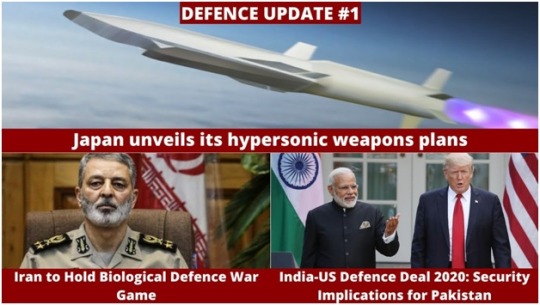
#hyderabad#civilservicescoachinginhyderabad#ias coaching in hyderabad#civilservicescoachingcentersinhyderabad#iascoachingcentersinhyderabad#pragnyaiasacademy#Bangalore#civilservicescoachinginbangalore#iascoachinginbangalore#civilservicescoachinginstitutesinhyderabad#best civils coaching info#bestiascoachingcentersinhyderabad#best ias coaching classes#best ias coaching in hyderabad#civilservices
0 notes
Link
Following an infructuous spell of looking east, India’s Act East Policy (AEP) is hobbled by snags in connectivity, continuing insurgencies, agitations, blockades and extortion in the North-east and replication of some of these very problems, especially insurgencies and snarls, in decision-making in Myanmar, the launchpad and fulcrum of AEP. Last month, the visit of Myanmar President, U Win Myint, to India reminded us of AEP anew.
The open-door policy is intended to usher in development in the North-east, which could in turn facilitate the closure of insurgencies. For the Look East Policy to work, it was necessary to press the “pause” button on democracy and, instead, support the ruling military junta. Reversion to democracy, albeit partial, has been achieved as I discovered last month in Yangon through a joint civil military leadership, with the Army having the last word.
At the core of AEP is connectivity — by road, rail, sea, inland waterways and air. The strategic geography in the North-east channelises this outreach through the narrow and sensitive Siliguri corridor, the vulnerable chicken’s neck of the region. Choices for bypassing the Siliguri constriction were to transit through Bangladesh and/or use the sea route to reach insurgency-free Mizoram on the Myanmar border — from Kolkata to Sittwe Port in Myanmar and upto Mizoram.
Earlier, Bangladesh had rejected Indian requests to connect Myanmar through the Port of Chittagong upto Agartala and thence to the Myanmar border. What is being operationalised now is the costly and delayed Kaladan multi-modal access from Sittwe to Myanmar/Mizoram through Rakhine and Chin States, currently beset with insurgencies by the Arakam Army. Therefore, instead of working this project south-north, it has been reversed, starting from Mizoram to Sittwe, which will have a 1,000 km special economic zone (SEZ) and a gas land pipeline from its gasfields to Gaya in Bihar. A number of roads to and through Myanmar to the east are under construction and completion, thus enhancing the AEP connectivity grid.
Unique to Myanmar is the civil-Army joint leadership arrangement under an Army-dictated constitution of 2011, which ensures that 25 per cent of the elected seats in Parliament is reserved for the Army. As the Constitution forbids Myanmar’s popular leader Daw Aung San Suu Kyi of the National League of Democracy (NLD) from holding office, she is a State Councillor in the improvised system, which allows her the number three position in the State hierarchy after the President and Vice President; whereas the “C” in C Senior General Aung Hlaing, who calls the shots, is at number five. The Constitution reserves the posts of defence, home and border affairs Ministers for the Army.
The NLD wants to change the Constitution, which requires an unachievable two-thirds majority in Parliament. Last week, State Counsellor Aung San Suu Kyi unsuccessfully tried to pass the Constitutional amendment. Senior General Min Aung Hlaing is in his second term, which will end in April 2021, and efforts are on to accommodate him as the Vice President. This may introduce a modicum of civilian control over the military. While the Army is popular in the countryside, it is disliked by the urban elite. It disapproves of the overwhelming Chinese presence and meddling in Myanmar’s internal affairs. But others don’t mind them as they have the money to invest and develop the country.
Another historical challenge facing Myanmar is its myriad insurgencies, which like the cluster on the Indian side, is a hurdle for AEP. At the time of independence, many States in the erstwhile Burma had sought self-determination and separation but the Panglong Agreement of 1947 promised to settle Centre-State relations even as the Communists and Karens favoured independence. Today, there are more than two dozen active and dormant insurgencies, the active ones in border States like Shan, Kachin, Chin and Rakhine. The world’s most complex but elaborate peace process is in Myanmar and it consists of unilateral, bilateral and a nationwide cease fire agreements, prone to violations and formal and informal dialogues backed by the international community, prominently by China.
The year 2019 was bad for the peace process. The 21st century Panglong Union Peace Conference with 10 nation-wide ceasefire signatories and the high-level Joint Implementation Coordination Meeting could not be held, though the Union Peace Dialogue took place in July. Both the failed meetings are likely to be held after the national elections later this year, which the Lady — reference to NLD leader Daw Suu Kyi — is expected to win but with a reduced majority. For various reasons, her popularity has waned but there is no alternative leader.
Chinese President Xi Jinping visited Myanmar this January and signed 33 agreements, of which the China-Myanmar Economic Corridor (like the economic corridors with Pakistan and Nepal) was the centre piece. All three strategic corridors seek access to markets but two have an eye on warm waters of the Indian Ocean. Surpassing India’s port potential at Sittwe is Kyakpyu, the deep-water port coupled with SEZ and ultimately road, rail, oil and gas pipelines radiating through Myanmar north of China’s Yunnan province. China’s footprint is enormous: There are hordes of Chinese in the north. Though the controversial $3.6 billion hydel dam at Myitsone has been put on hold, bilateral trade stands at $17 billion and China holds 40 per cent of Myanmar’s foreign debt of $5 billion. Xi signed separate agreements with the Senior General and State Councillor while hailing the new blueprint for comprehensive strategic cooperation and the new 2+2 strategic dialogue, Myanmar’s first with any country.
India, though with good intentions and now sizeable civil and defence cooperation, is no match for China’s deep pockets and outreach to play the role of a regional equaliser. Still, its impressive infrastructure and capacity-building programmes have been appreciated.
Japan will team up in improving quality and quick delivery of projects. While the two million, mostly Indian Tamil, diaspora is no asset, the Buddhism connect has not been tested even as Indian tourists are thronging Myanmar. India has transferred a Russian kilo-class diesel-electric attack submarine and may soon sell Brahmos missiles against the $1.5 billion line of credit, of which $300 million is left. Border trade — within 16 km — is a paltry $25 million, though overall trade is around $2.5 billion, far below potential.
The flowering of bilateral relations is stalled in part by the complexity of joint leadership and the unstoppable rise of China. While Beijing has cast a string of pearls along India’s periphery, it has placed in Myanmar, an arrestor wire system of an aircraft carrier to blunt the take-off of AEP towards Asean, where China is also the dominant influencer. Myanmar’s full transition to democracy depends on progress in ethnic reconciliation and resolving civil-military tensions through Constitutional reform. Till then, AEP will remain constrained.

#hyderabad#civilservicescoachinginhyderabad#ias coaching in hyderabad#civilservicescoachingcentersinhyderabad#iascoachingcentersinhyderabad#Bangalore#civilservicescoachinginbangalore#iascoachinginbangalore#best ias coaching in hyderabad#best ias coaching classes#best civils coaching info#bestiascoachingcentersinhyderabad#civilservicescoachinginstitutesinhyderabad#civilservices#pragnyaiasacademy
0 notes
Link
Under Skill India Mission, Ministry of Skill Development and Entrepreneurship is implementing its demand driven flagship scheme Pradhan Mantri Kaushal Vikas Yojana (PMKVY) with an objective to provide skilling to one crore people across the country in four years i.e. 2016-2020. As on 17.01.2020, 40.27 lakh and 32.34 lakh candidates have been trained and certified, respectively, under Short Term Training (STT) courses. Out of these certified candidates, 16.61 lakh candidates have been provided with placement opportunities. Also, 33.20 lakh candidates have been oriented under Recognition of Prior Learning (RPL) component of the scheme.
Start-up India is a flagship initiative of the Government of India, intended to catalyse start-up culture and build a strong and inclusive ecosystem for innovation and entrepreneurship in India. The Department for Promotion of Industry and Internal Trade (DPIIT) acts as the nodal Department for the Start-up initiative. As on December 31, 2019, 26,804 startups across 555 districts have been recognized as startups by DPIIT. Employment of 3,06,848 jobs has been reported by 24,848 startups with an average number of 12 employees per startup."
Under PMKVY (2016-20), in order to inculcate entrepreneurship in the candidates, training in English, Employability & Entrepreneurship (EEE) module of 155 hours is being imparted in addition to core curriculum of course. Further, TPs provide support for entrepreneurship development through facilitating bank linkages along with providing guidance and mentoring support. In addition, Pradhan Mantri Kaushal Kendras (PMKKs) are designated as Hand Holding Agencies for MUDRA loans on Udyamimitra Portal Small Industries Development Bank of India (SIDBI).
Under Stand-up India, assistance to Startups includes setting up Fund of Funds for Startups’ (FFS) at SIDBI for providing fund support for Startups, relaxed norms in Public Procurement for Startups, Tax incentives, Legal Support and Fast-tracking Patent examination at Lower costs, Self-Certification based Compliance Regime, Setting up of Incubators and Tinkering Labs, etc.
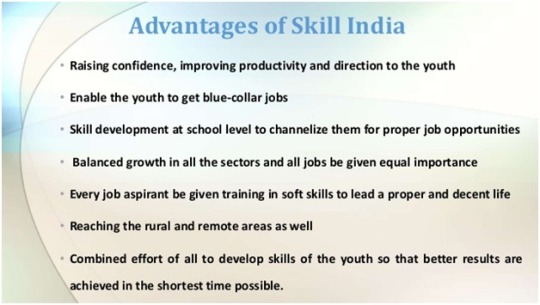
#hyderabad#civilservicescoachinginhyderabad#civilservicescoachingcentersinhyderabad#ias coaching in hyderabad#iascoachingcentersinhyderabad#Bangalore#civilservicescoachinginbangalore#iascoachinginbangalore#civilservicescoachinginstitutesinhyderabad#best ias coaching in hyderabad#best ias coaching classes#best civils coaching info#bestiascoachingcentersinhyderabad#pragnyaiasacademy#civilservices
0 notes
Link
The main objectives of Unnat Bharat Abhiyan (UBA) are as under:
i. To engage the faculty and students of Higher Educational Institutions (HEIs) in identifying development issues in rural areas and finding sustainable solutions for the same.
ii. Identify & select existing innovative technologies, enable customisation of technologies, or devise implementation method for innovative solutions, as required by the people.
iii. To allow HEIs to contribute to devising systems for smooth implementation of various Government programmes.
Unnat Bharat Abhiyan 2.0 is the upgraded version of Unnat Bharat Abhiyan 1.0.The scheme is extended to all educational institutes; however under Unnat Bharat Abhiyan 2.0 Participating institutes are selected based on the fulfillment of certain criteria.
Unnat Bharat Abhiyan is inspired by the vision of transformational change in rural development processes by leveraging knowledge institutions to help build the architecture of an Inclusive India. Currently under the scheme UBA, 13072 villages have been adopted by 2474 Institutes. The technology interventions under the scheme Unnat Bharat Abhiyan has been able to transform the living conditions in villages. The technological interventions under the UBA cover different subjects broadly categorized like in the area of sustainable agriculture; water resource management; artisans, industries and livelihood; basic amenities (infrastructure & services) and rural energy system. With the interventions in the abovementioned areas, various new and old technologies has been developed which have transformed the living conditionsin villages and has been beneficial for rural India.
Some technological interventions done under scheme UBA are; i)Mushroom Cultivation done in Gendikata cluster by IIT Delhi; ii) Environment Controlled Automated Green House For High Valued Agro Produce by HVPM College of Engineering and Technology (Amravati); iii) Safe Drinking Water by NIT Manipur and IIT Jodhpur; iv)Paper bag making by BITS Mesra; v)Pattal crockery making by NIT Hamirpur; vi) Cloth Bag making by Fatima College, Madurai; vii) Revamping of Govt. schools in Vrindavan Cluster by IIT Delhi; viii) Improved Pottery Kiln in farrukhnagar cluster by IIT Delhi; ix)Thread winding machine for weavers by Dr. B. R. Ambedkar University, Etcherla; x) Agriculture drone system by Santhiram Engineering College, Nandyal (A.P) etc.
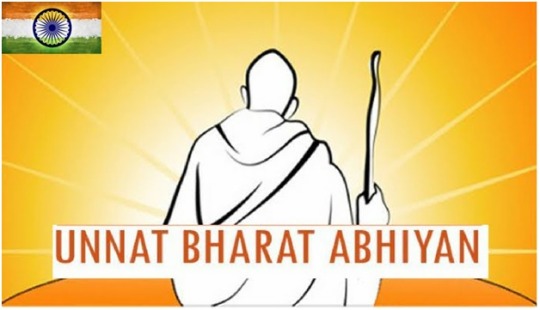
#hyderabad#civilservicescoachinginhyderabad#ias coaching in hyderabad#civilservicescoachingcentersinhyderabad#iascoachingcentersinhyderabad#pragnyaiasacademy#Bangalore#civilservicescoachinginbangalore#iascoachinginbangalore#civilservices#civilservicescoachinginstitutesinhyderabad#bestiascoachingcentersinhyderabad#best civils coaching info#best ias coaching classes#best ias coaching in hyderabad
0 notes
Link
The Ministry of Skill Development and Entrepreneurship (MSDE) is implementing a pilot scheme, Pradhan Mantri YUVA (PM YUVA) Yojana towards creating an enabling ecosystem through entrepreneurship education, training, advocacy and easy access to entrepreneurship network.
The scheme focuses on students/trainees and alumni coming out from skilling ecosystem {i.e. Industrial Training Institutes (ITIs), Polytechnics, Pradhan Mantri Kuashal Kendras (PMKKs) and Jan Sikshan Sansthans (JSS)}. The scheme is being implemented in 10 States and 2 Union Territories {viz. i.e. Uttar Pradesh (6 districts), Uttarakhand (4 districts), Bihar (10 districts), West Bengal (12 districts), Assam (11 districts), Meghalaya (2 districts), Maharashtra (5 districts), Tamil Nadu (17 districts), Telangana (8 districts), Kerala (4 districts), Delhi (1 district) and Puducherry (1 district)}. The scheme envisages creation of 600 new and 1000 scale-up enterprises. Under the scheme, mobilisation campaigns are being organized to spread awareness about entrepreneurship as a career option among various potential target groups. Further, orientation workshops are being conducted on entrepreneurship in the project institutes for aspiring/potential entrepreneurs.
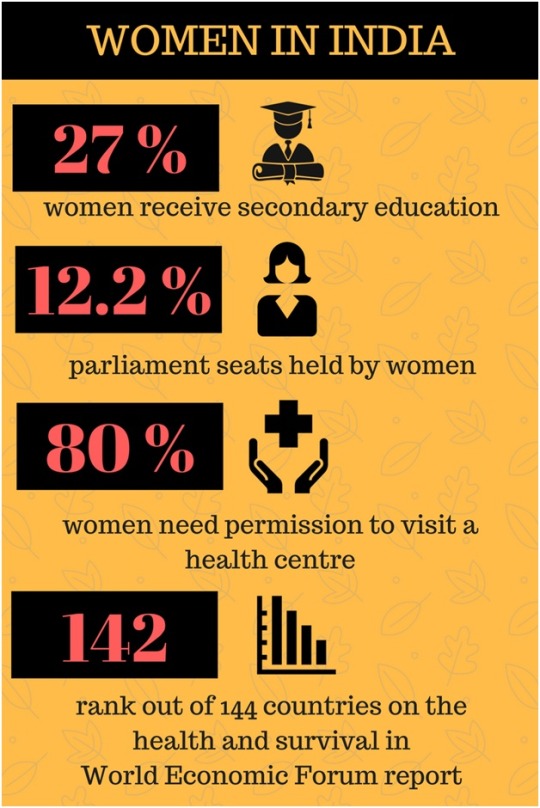
Further, MSDE in collaboration with GIZ, Germany has launched a pilot project called ‘Economic Empowerment of Women Entrepreneurs and Start-ups by Women’ to support aspiring and existing women entrepreneurs in India. Presently, this pilot programme is being implemented in the North Eastern Region (Assam, Meghalaya and Manipur), Rajasthan and Telangana where 147 women have been given incubation and acceleration support as part of its first cohorts.
Furthermore, with an aim to promote a culture of entrepreneurship among India’s youth and inspire them to set-up their own enterprise and create employment opportunities for others, National Entrepreneurship Awards Scheme (NEAS) has been instituted in 2016. Under the scheme, awards are conferred to the aspiring first generation entrepreneurs including women and those individuals/ organizations who are working as eco-system builder in the field of entrepreneurship development. The awards also seek to highlight model of excellence for others to emulate and improve upon. So far, out of a total of 95 awards conferred (including 8 awards to the entrepreneurs and two awards to the eco-system builders from Karnataka) during last 4 years (2016 to 2019), 39 women have received National Entrepreneurship Awards including 1 women awardee (Healthcare Sector in Year 2018) from Karnataka.
In addition to the above, Government is providing financial assistance in form of loan to entrepreneurs under various schemes viz Rashtriya Mahila Kosh (exclusively for women) implemented through Ministry of Women and Child Development, Stand Up India Scheme implemented through Department of Financial Services (Ministry of Finance), Start-up Village Entrepreneurship Programme implemented through Ministry of Rural Development and Micro Units Development and Refinance Agency (MUDRA) implemented by Department of Financial Services (Ministry of Finance).
This information was given by the Minister of State for Skill Development and Entrepreneurship Shri R.K. Singh in a written reply in the Lok Sabha today.
#hyderabad#civilservicescoachinginhyderabad#ias coaching in hyderabad#iascoachingcentersinhyderabad#civilservicescoachingcentersinhyderabad#bangalore#civilservicescoachinginbangalore#iascoachinginbangalore#pragnyaiasacademy#civilservices#civilservicescoachinginstitutesinhyderabad#bestiascoachingcentersinhyderabad#best civils coaching info#best ias coaching in hyderabad#best ias coaching classes
0 notes
Link
When the Tamil Nadu Legislative Assembly passed the Protected Agricultural Zone Development Bill, 2020 on February 19, 2020, farmers heaved a sigh of relief.
The new Act declared the Cauvery delta region a Protected Special Agriculture Zone (PSAZ). It proposed to protect agriculture and prohibit Petroleum, Chemical and Petrochemical Investment Regions (PCPIRs) and hydrocarbon projects in the delta region.
However, activists and farmer associations flagged a major gap in the Act — it did not cover all districts of the Cauvery delta.
The proposed PSAZ comprises Thanjavur, Tiruvarur and Nagapattinam districts and some blocks in Cuddalore and Pudukkottai districts. It, however, excluded Tiruchirappalli, Ariyalur and Karur districts and other parts of Cuddalore and Pudukottai, though they also fall in the delta zone.
Farmers in these parts cultivate rice as their primary crop and pulses such as blackgram and greengram as their secondary crop. They also cultivate seasonal vegetables and fruits.
In August 2018, the Central government approved unconventional hydrocarbons policy that permitted exploration and exploitation of unconventional hydrocarbons such as shale oil/gas, coal bed methane (CBM), etc.
This was a major concern in the Cauvery delta, a sight for gas exploration activities since 1985 that has adversely affecting farming and livelihood. Several farmer associations condemned the Union government order and staged protests.
According to activists, the Bill also did not address issues regarding existing industrial and oil extraction projects in the delta region.
According to G Sundar Rajan of Poovulagin Nanbargal, a Tamil Nadu environment group, more than 400 projects were already underway in parts of the now protected zone.
Additionally, Haldia Petrochemicals Ltd was set to invest Rs 50,000 crore in a Nagarjuna Oil project in Cuddalore’s Kayalpattu village. Some parts of Cuddalore falls out of the protected zone ambit.
“At first, the state government planned to make nine districts of Cauvery Delta as Protected Special Agricultural Zone (PSAZ). But they did not do so. We want the entire Cauvery delta region to be declared as PSAZ,” Professor T Jayaraman, coordinator of Tamil Nadu-based welfare group Anti-Methane Project Federation, said.
He added that according to the current Bill, ports, pipelines and telecommunications projects in the PSAZ would not be affected, which was a problem.
“Chief Minister Edappadi K Palaniswami said ongoing projects would not be affected. These are the disadvantages of the Bill. These issues should be addressed some way or the other. I consider this is a starting point. Many political parties openly opposed these hydrocarbon projects. However, no party was interested to stop them,” he added.
“Even when the Bill was passed, hydrocarbon exploration was underway in Ariyalur district, because it wasn't included in PSAZ. There was no mention of soil mining in the Bill. These are the gaps that need to be addressed,” Rajan said.
PR Pandian, general secretary, Tamil Nadu Cauvery Delta Farmers Association, said farmers were happy with the recent developments: “But we want these plans to be implemented effectively. We have already lost our water resources to industrial mess. We cannot lose them anymore.”
Tamil Nadu environment minister KC Karuppannan did not respond to Down to Earth’s queries.
Another issue plaguing Cauvery Delta is water scarcity.
According to Jayaraman, Tamil Nadu had been facing water scarcity since 1970s. Earlier, farmers used Cauvery water for agriculture purposes. However, when the dispute on Cauvery water sharing came up, farmers started to rely on groundwater.
"At the same time, industries boomed in the delta. This drastically impacted agriculture and livelihood of farmers. Agriculture cannot be done only depending on groundwater,” Jayaraman added.
He added that the delta region had nearly 28 lakh acres of cultivable land, which has now come down to 15 lakh acres. He attributed “Central government's partiality towards Tamil Nadu and lack of enough Cauvery water” for the same.
He claimed: “This Central government approach can't be allowed at any cost. We are only demanding what is our right. But their approach towards water dispute is affecting our needs and agriculture.”
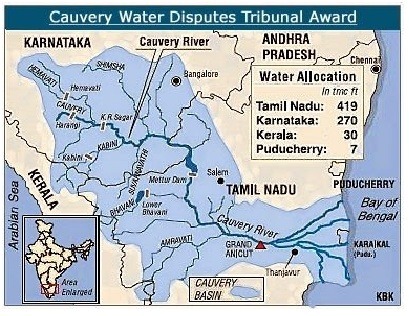
#hyderabad#civilservicescoachinginhyderabad#ias coaching in hyderabad#civilservicescoachingcentersinhyderabad#iascoachingcentersinhyderabad#Bangalore#civilservicescoachinginbangalore#iascoachinginbangalore#civilservicescoachinginstitutesinhyderabad#best ias coaching in hyderabad#best ias coaching classes#best civils coaching info#bestiascoachingcentersinhyderabad#civilservices#pragnyaiasacademy
0 notes
Link
European Space Agency cited software problems with the spacecraft as a reason for the delay
The European Space Agency (ESA) and its Russian counterpart Roscosmos State Corp have delayed the launch of their second ExoMars mission by two years to 2022.
The mission aims to determine if there is any life on Mars and to better understand the history of water on the planet.
In a press release, ESA cited software problems with the spacecraft that would carry the rover as well as the main parachute testing as reasons for the delay. According to journal Nature, space agencies also cited coronavirus pandemic as a reason for the same.
According to an ESA press note:
Due to consideration of the recommendations provided by European and Russian inspectors general, ExoMars experts have concluded that tests necessary to make all components of the spacecraft fit for the Mars adventure need more time to complete.
The rover, Rosalind Franklin, was expected to take off to Mars in July 2020 and arrive at the planet’s surface in March 2021. It includes a drill to access the sub-surface of Mars.
According to ESA press note, Director-General Jan Wörner on March 12 said:
“Although we are really close to launch readiness, we cannot cut corners. We have together accepted the advice that launching this year would mean sacrificing essential remaining tests.”
He added: “This is a tough decision but I’m sure it’s the right one.”
According to Roscosmos Director-General Dmitry Rogozin, the need to maximise robustness of all ExoMars systems prompted the decision.
“We have made a difficult but weighed decision to postpone the launch. It is driven primarily force majeure circumstances related to exacerbation of the epidemiological situation in Europe. I am confident that the steps that we and our European colleagues are taking to ensure mission success will be justified,” he added.
The Rosalind Franklin rover is the second part of the two space agencies’ ExoMars mission. The first part of the mission — the Trace Gas Orbiter spacecraft — was launched successfully in 2016.

#hyderabad#civilservicescoachinginhyderabad#civilservicescoachingcentersinhyderabad#ias coaching in hyderabad#iascoachingcentersinhyderabad#Bangalore#civilservicescoachinginbangalore#iascoachinginbangalore#civilservices#civilservicescoachinginstitutesinhyderabad#bestiascoachingcentersinhyderabad#best civils coaching info#best ias coaching classes#best ias coaching in hyderabad#pragnya
0 notes
Link
The Union government has notified the Protection of Children from Sexual Offences Rules, 2020 which enables implementation of recent amendments to the Act under which provisions of punishment for child abuse has been made more stringent.
Some of the significant additions in the new rules include provision of mandatory police verification of staff in schools and care homes, procedures to report sexual abuse material (pornography), imparting age-appropriate child rights education among ot hers.
For crackdown on child pornography, the rules state that "any person who has received any pornographic material involving a child or any information regarding such pornographic material being stored, possessed, distributed, circulated, transmitted, facilitated, propagated or displayed, or is likely to be distributed, facilitated or transmitted in any manner shall report the contents to the special juvenile police unit (SJPU) or police, or the cybercrime portal".
"The report shall include the details of the device in which such pornographic content was noticed and the suspected device from which such content was received including the platform on which the content was displayed," the rules said.
Under the rules, the state governments have been asked to formulate a child protection policy based on the principle of "zero-tolerance" to violence against children, which shall be adopted by all institutions, organisations, or any other agency working with, or coming in contact with children.
"The central government and every state government shall provide periodic training including orientation programmes, sensitisation workshops and refresher courses to all persons, whether regular or contractual, coming in contact with the children, to sensitise them about child safety and protection and educate them regarding their responsibility under the Act," the rules said.
The Centre and state governments have been asked to prepare age-appropriate educational material and curriculum for children, informing them about various aspects of personal safety, including measures to protect their physical and virtual identity; and to safeguard their emotional and mental wellbeing, prevention and protection from sexual offences and reporting mechanisms, including Childline helpline services through toll free number - 1098.
"Orientation programme and intensive courses may also be organised for police personnel and forensic experts for building their capacities in their respective roles on a regular basis," it said.
Under the new rules, any institution housing children or coming in regular contact with children, including schools, creches, sports academies or any other facility for children must ensure a police verification and background check on periodic basis of every staff.
The new POCSO rules became effective from March 9.
The POCSO Act was enacted in 2012 to provide a robust legal framework for the protection of children from offences of sexual assault, sexual harassment and pornography, while safeguarding the interests of children at every stage of the judicial process.
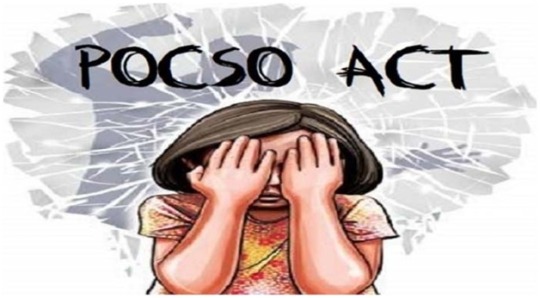
#hyderabad#civilservicescoachinginhyderabad#ias coaching in hyderabad#iascoachingcentersinhyderabad#civilservicescoachingcentersinhyderabad#pragnyaiasacademy#Bangalore#iascoachinginbangalore#civilservicescoachinginbangalore#bestiascoachingcentersinhyderabad#best ias coaching classes#best ias coaching in hyderabad#best civils coaching info#civilservicescoachinginstitutesinhyderabad#civilservices
0 notes
Link
Is there a difference between using soap and water and alcohol-based hand sanitisers?
Ever since the novel coronavirus (SARS-CoV-2) outbreak began in China in end-December 2019, various measures have been mentioned to reduce the risk of infection. Guidelines by the World Health Organization specify that one of the ways to reduce the risk of infection is by regularly and thoroughly cleaning one’s hands with an alcohol-based hand rub or washing them with soap and water. Regular washing becomes important as the virus tends to be viable from hours to more than a day on different surfaces that are regularly touched with hands.
How does washing with soap help get rid of the coronavirus?
The grime on our hands contains innumerable viruses and bacteria. Washing with water without using soap helps reduce the amount of microbes but does not remove most of the virus and bacteria completely. Using soap, therefore, becomes far more effective in removing microbes.
Viruses such as coronavirus, influenza-causing viruses, Ebola, Zika have their genetic material encased in a layer of fat called the lipid envelop. Soap molecules are pin-shaped with a head that is water-loving (hydrophilic) and a tail that is oil-loving (oleophilic). Being oleophilic, the tail portion of the molecule tends to have an affinity for and ‘competes’ with the lipids in the virus envelope. Since the chemical bonds holding the virus together are not very strong, the long oleophilic tail gets inserted into the envelope and tends to have a ‘crowbar’ effect that breaks the lipid envelope of the virus. The tail also competes with the bond that binds the RNA and the lipid envelop thus dissolving the virus into its components which are then removed by water.
Do all viruses have the lipid layer?
No, certain viruses do not have the lipid envelop and are called the non-enveloped viruses. Rotavirus which causes severe diarrhoea, poliovirus, adenovirus that cause pneumonia and even human papillomavirus (HPV) do not contain the lipid envelop.
The oil-loving tail of the soap molecule also disrupts the bond that binds dirt and non-enveloped viruses to the hand. The dirt and viruses are surrounded by several tails making them remain as suspended particles. Rinsing with water washes away the suspended particles leading to clean hands.
How do alcohol-based hand sanitisers help get rid of coronavirus?
Like soap, the alcohol present in hand sanitisers dissolve the lipid envelop, thus inactivating the virus. In addition, the alcohol also tends to change the shape or denature the mushroom-shaped protein structures that stick out of the lipid envelop. The mushroom-shaped protein structures help the virus to bind to special structures found on human cells and enter the cells. To be effective, the sanitisers should contain at least 60% alcohol.
Unlike soap lather, the alcohol does not come in contact with all parts of the hand. So care needs to be taken to use sufficient amount of sanitiser to increase the coverage. Unlike water, alcohol run does not remove the dead viruses from the hand. While a sanitiser can quickly reduce the number of microbes, it does not get rid of all types of germs, and is “not as effective when hands are visibly dirty or greasy”.
Should healthy people who are not taking care of COVID-19 patients use a mask?
Medical masks help prevent the spread of coronavirus infection. If worn properly, masks may be effective in preventing transmission of coronavirus. An article published in the Journal of the American Medical Association (JAMA) says there is no evidence to suggest that masks worn by healthy individuals can help prevent infection.
But a 2010 study says: “Mask wearing was associated with reduced secondary transmission and should be encouraged during outbreak situations.”
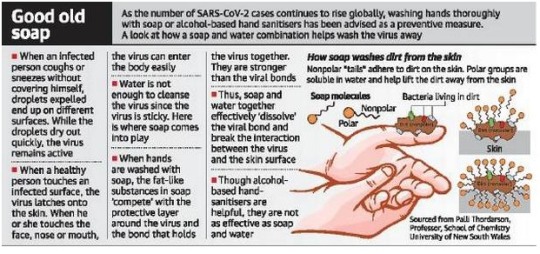
#hyderabad#iascoachingcentersinhyderabad#civilservicescoachingcentersinhyderabad#ias coaching in hyderabad#civilservicescoachinginhyderabad#Bangalore#civilservicescoachinginbangalore#iascoachinginbangalore#pragnyaiasacademy#civilservicescoachinginstitutesinhyderabad#bestiascoachingcentersinhyderabad#best civils coaching info#best ias coaching classes#best ias coaching in hyderabad#civilservices
0 notes
Link
Researchers argue that in an open economy, policymakers can simultaneously achieve only two of three key objectives: financial stability, independent national financial policies, and cross-border financial integration
The rapid spread of Covid-19 has predictably stirred fears around greater globalization and created ripple effects on financial markets globally, complicating the task of central bankers and policymakers across the world.
Such risks are par for the course in a globalized world, making it tougher for central banks to maintain financial stability, wrote economists Simone Arrigoni, Roland Beck, Michele Ca’ Zorzi, and Livio Stracca in VoxEu, a research portal run by the Centre of Economic Policy Research (CEPR).
The researchers argue that in an open economy, policymakers can simultaneously achieve only two of three key objectives: financial stability, independent national financial policies, and cross-border financial integration.
This “financial trilemma" means that unless policymakers are prepared to tame globalization, preserving financial stability would require compromising the independence of monetary policy.
The researchers find that both real economy indicators, such as output and physical investments, and financial indicators, such as bank credit and stock prices, tend to move together across countries.
This “co-movement" is much stronger in reality than suggested by economic theory. Given the growing financial linkages in a globalized world, this means that the real sector of different countries are much more intertwined than ever before.
The researchers show that in the high globalization period (post-2003) such cross-country linkages were higher for most economic variables compared to the period of relatively low globalization (pre-2003). Better use of macro-prudential policy tools, such as limits on debt exposure and flexible reserve requirements, can help policymakers combat global headwinds better, the researchers write.

#hyderabad#civilservicescoachinginhyderabad#ias coaching in hyderabad#civilservicescoachingcentersinhyderabad#iascoachingcentersinhyderabad#pragnyaiasacademy#Bangalore#civilservicescoachinginbangalore#iascoachinginbangalore#bestiascoachingcentersinhyderabad#best civils coaching info#best ias coaching classes#best ias coaching in hyderabad#civilservices#civilservicescoachinginstitutesinhyderabad
0 notes
Link
The new coronavirus outbreak can now be described as a pandemic, the head of the World Health Organization announced Wednesday.
WHO chief Tedros Adhanom Ghebreyesus said he was troubled by the spread and severity of the outbreak, along with a lack of action taken to combat it.
"WHO has been assessing this outbreak around the clock and we're deeply concerned, both by the alarming levels of spread and severity, and by the alarming levels of inaction," he told a news conference in Geneva.
"We have therefore made the assessment that COVID-19 can be characterised as a pandemic."
The number of cases in over 100 countries around the world has risen to more than 124,000, with over 4,500 deaths, including a jump in fatalities in Iran and Italy in particular, according to an AFP tally.
China remains the worst-affected country with more than 80,000 confirmed cases and over 3,000 deaths.
Tedros said that over the past two weeks, the number of cases outside China had increased 13-fold and the number of affected countries had tripled.
He said he expected the number of cases and deaths would grow in the coming days and weeks.
"Pandemic is not a word to use lightly or carelessly," he told reporters, but he stressed that "describing the situation as a pandemic does not change WHO's assessment of the threat posed by the virus."
It should not be taken by countries as a signal to give up on efforts to contain the virus with methods like contact-tracing, he said.
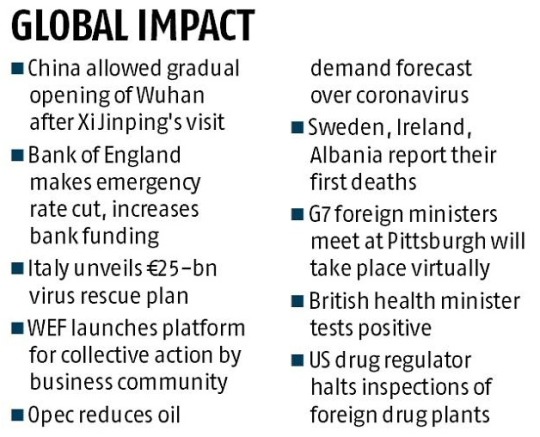
Tedros pointed out that over 90 percent of cases had been registered in just four countries, and that countries with no or only a few cases could still halt the virus in its tracks.
"We should double down, and we should be more aggressive," Tedros said, adding: "We are not saying the world should move from containment to mitigation... the blended approach should continue.
"It will be a mistake to abandon the containment strategy," he said.
He acknowledged that the world had "never before seen a pandemic sparked by a coronavirus," but emphasised that "we have never before seen a pandemic that can be controlled at the same time." Countries can still change the course of the outbreak, he said.
Michael Ryan, who heads WHO's emergencies programme, insisted on the need to slow the outbreak to give time to hospitals to prepare for more cases, warning that many countries' health systems were showing a lack of resilience.
"If you do not try to suppress this virus it can overwhelm your health system," he said.
Tedros said the WHO was grateful for the measures being taken in countries around the globe and was aware that they were taking a "heavy toll" on societies.
He also said hard-hit Iran was trying its best to control the outbreak but needed more supplies.
Iran is suffering from a shortage of ventilators, oxygen and protective gear for health workers, reporters were told.
#hyderabad#civilservicescoachinginhyderabad#iascoachingcentersinhyderabad#civilservicescoachingcentersinhyderabad#ias coaching in hyderabad#Bangalore#civilservicescoachinginbangalore#iascoachinginbangalore#bestiascoachingcentersinhyderabad#best civils coaching info#best ias coaching classes#best ias coaching in hyderabad#civilservicescoachinginstitutesinhyderabad#civilservices
0 notes
Link
India can learn from China, Japan in use of UAVs for improved pest management and crop productivity.
Indian farmers are yet to reap the full benefits of the economic reforms initiated in 1991. Besides, they face structural challenges that include fragmented landholdings, lack of adequate market access, rising costs (especially of human labor), poor/below par yields in most crops and — not the least — low usage of modern technology relative to their counterparts in the US, Europe, Brazil, Argentina or China.
Satellite-driven technology, big data analytics, and digital solutions are helping farmers in many countries today make more informed cropping decisions with regard to weather, soil nutrient application, and pest and disease control. Many of these technologies are likely to be introduced in India over the next few years.
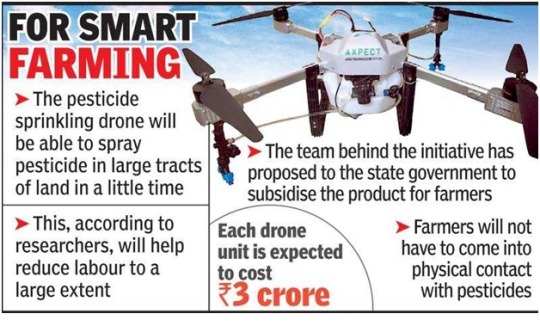
One area that we believe can have a major impact on our farms, and needs quick government intervention, is the use of drones for spraying of agrochemical products.
The main benefits of drones are increased efficiency and precision of agrochemical applications, in turn, leading to improved pest management and crop productivity as well as a significant reduction in operator exposure during spray operations. The field capacity of drone-assisted spraying is about 20 times higher than that of manual spraying. The other benefits are lower water consumption (as the material is sprayed in concentrated formulations) and the development of licensed applicators. These include community spraying professionals who may provide application services to farmers similar to combine harvester operators, thereby creating new skilled employment potential in rural India.
The investment banker Goldman Sachs has forecast the agriculture sector to be the second-largest global commercial/civil user of drones, after construction, by the end of this year. Drones in agrochemical application have, in just a few years, grown in sophistication and scale, boosting the ease and affordability of use. The good news is that this innovation is being driven largely by Asia. The adoption of drones in farms is the highest in countries such as China, Korea, and Japan, which are also confronting growing labour shortage challenges from urbanisation and ageing populations.
In China, the world’s biggest civilian drones manufacturer, the number of these machines deployed in agriculture is estimated to have doubled to around 13,000 between 2016 and 2017, with the total unmanned aerial vehicles (UAV)-treated acreage, too, trebling to reach roughly 7 million hectares. The economies of scale in usage have meant that the per-hectare operating costs in China are now equivalent to just Rs 100-150 for field crops (rice, wheat and maize) and Rs 250-400 in orchards.
Our farmers, too, can immensely benefit through swift adoption of this nascent technology by taking a leaf from China’s book. However, for this, the government, both at the Centre and states, must respond in a timely manner through a sound regulatory framework, so as to prevent uncontrolled and inappropriate use. The focus should be to minimise the potential risks that come with the unfamiliarity and rapid adoption of an emerging technology.
The first step in establishing a robust policy framework is to identify the various risks associated with drone application and the processes to deal with them. These cover the specifications for the drones/UAVs and the agrochemical formulations being used, the capabilities of the spray operators and training standards, and environmental variables. Based on these, a Standard Operating Procedure (SOP) should be put in place for spray operators, drone manufacturers and agrochemical companies to comply with.
Here, it is worth looking at Japan and borrowing from the requirements — both for the licensing of UAVs and operators, as well as product registration for drone spraying — stipulated in the country’s most recent revised 2019 guidance document. Having a long history in the use of UAVs — especially remote-controlled helicopters or RCHs — for spraying of agrochemicals and with over 30 years of data generation, Japan provides the strongest point of reference for framing the appropriate rules and SOPs. As an industry association representing around 70% of India’s crop protection market, we recommend that the government develops a regulatory framework for deploying drones in agrochemical spraying based on the experience and best practices of a country such as Japan.
The necessary regulations should take into consideration (1) civil aviation laws (both local and umbrella) and the setting of vehicle specifications, (2) SOPs and piloting requirements for safe use, and (3) product approvals and permissions for spray operations. In addition to the general regulations, we would recommend at least four other criteria to be met for obtaining permission: (1) approval of vehicle needs, (2) licensing of pilots/operators and training for agrochemical application by drones, (3) registration of agrochemical products sought to be sprayed, and (4) strict adherence to label instructions on products.
More specifically, we propose the setting up a system for certification or licensing of drone operators to ensure their capability for piloting the UAV machines safely. Such certification/licensing should be subject to regular renewals and conducting of refresher courses. The authorities should also accredit training facilities to put in place a standardised programme for all agricultural drone operations.
The product registration process must be simplified and not duplicated from scratch, more so if the drone use is just an extension for a formulation that is already approved for conventional manual spraying. The idea is to reduce registration timelines and make available the same crop protection products to farmers through a new spraying technology, without compromising on safety. The Japanese guidelines stipulate that the bio-efficacy and maximum residue limits (MRL) data for drone/UAV applications be considered equivalent to that of conventional spraying, so long as the critical parameters (active ingredient dose per hectare, pre-harvest intervals and number of applications/sprayings) are within a determined range. There is no need, therefore, for any separate UAV bio-efficacy and MRL trials, even if additional crop safety studies might be required in some cases.
It would be in the interest of farmers and even the industry if UAV/drone technology can be deployed for agrochemical applications. This should be supported by a robust and pragmatic science-based policy framework, with Japan’s revised guidance document serving as the most suitable point of reference for drafting our regulations.
#hyderabad#iascoachingcentersinhyderabad#civilservicescoachingcentersinhyderabad#ias coaching in hyderabad#civilservicescoachinginhyderabad#pragnyaiasacademy#bangalore#iascoachinginbangalore#civilservicescoachinginbangalore#best civils coaching info#best ias coaching classes#bestiascoachingcentersinhyderabad#best ias coaching in hyderabad#civilservices#civilservicescoachinginstitutesinhyderabad
0 notes
Link
Startup India initiative was announced by the Prime Minister of India on 15th August, 2015. The flagship initiative has an objective to build a strong eco-system for nurturing innovation and Startups in the country that will drive sustainable economic growth and generate large scale employment opportunities.
Further to this, an Action Plan for Startup India was unveiled by the Prime Minister of India on 16th January 2016. The action plan comprises of 19 action items spanning across areas such as “Simplification and handholding”, “Funding support and incentives” and “Industry-academia partnership and incubation”. Since its inception, 28,979, Startups across the country have been recognised by Department for Promotion of Industry and Internal Trade (DPIIT) as on 01.03.2020.
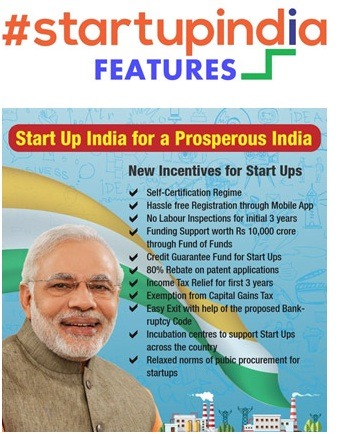
There is no provision under Startup India initiative for sanctioning of funds to startups directly. However, Government of India has established a Fund of Funds for Startups (FFS) with corpus of Rs. 10,000 crores, to meet the funding needs of startups. DPIIT is the monitoring agency and Small Industries Development Bank of India (SIDBI) is the operating agency for FFS. The total corpus of Rs. 10,000 crores is envisaged to be provided over the 14th and 15th Finance Commission cycles based on progress of the scheme and availability of funds. As on 18th February 2020, SIDBI has committed Rs 3123.20 crore to 47 SEBI registered Alternative Investment Funds (AIFs). These funds have raised a corpus fund of Rs. 25,728 crore. Further, the AIFs have invested a total of Rs. 3,378.47 crore into 320 startups out of which Rs. 912.91 crore have been drawn from Fund of Funds for Startups. Fund of Funds does not directly invest into startups but provides capital to SEBI-registered Alternate Investment Funds (AIFs), known as daughter funds, who in turn invest money in growing Indian startups through equity and equity-linked instruments. Thus, there is no direct fund allocation from DPIIT to States/UTs under Startup India initiative.
Startup India is an ongoing initiative. Necessary measures are being taken based on continuous consultations with all stakeholders.
Salient features of Startup India action plan
1. Compliance Regime based on Self-Certification with an objective to reduce the regulatory burden on Startups thereby allowing them to focus on their core business and keep compliance cost low.
2. Startup India Hub with an objective to create a single point of contact for the entire Startup ecosystem and enable knowledge exchange and access to funding.
3. Rolling out of Mobile App and Portal with an objective to serve as the single platform for Startups for interacting with Government and Regulatory Institutions for all business needs and information exchange among various stakeholders.
4. Legal Support and Fast-tracking Patent Examination at Lower Costs with an objective to promote awareness and adoption of IPRs by Startups and facilitate them in protecting and commercializing the IPRs by providing access to high quality Intellectual Property services and resources, including fast-track examination of patent applications and rebate in fees.
5. Relaxed Norms of Public Procurement for Startupswith an objective to provide an equal platform to Startups across sectors vis-à-vis the experienced entrepreneurs/ companies in public procurement.
6. Faster Exit for Startupswith an objective to make it easier for Startups to wind up operations.
7. Providing Funding Support through Fund of Funds with a Corpus of Rs. 10,000 crores with an objective to provide funding support for development and growth of innovation driven enterprises.
8. Credit Guarantee fund for Startupswith objective to catalyze entrepreneurship by providing credit to innovators across all sections of society.
9. Tax Exemptions on Capital Gains with an objective to promote investments into Startups by mobilizing the capital gains arising from sale of capital assets.
10. Tax Exemptions to startups for 3 Years with an objective to promote the growth of Startups and address working capital requirements.
11. Tax Exemption on Investments above Fair Market Value with an objective to encourage seed-capital investment in Startups.
12. Organizing Startup Fests for Showcasing Innovation and Providing a Collaboration Platform with an objective to galvanize the Startup ecosystem and to provide national and international visibility to the Startup ecosystem in India.
13. Launch of Atal Innovation Mission (AIM) with an objective to serve as a platform for promotion of world-class Innovation Hubs, Grand Challenges, Startup businesses and other self-employment activities, particularly in technology driven areas.
14. Harnessing Private Sector Expertise for Incubator Setup with an objective to ensure professional management of Government sponsored / funded incubators, Government will create a policy and framework for setting-up of incubators across the country in public private partnership.
15. Building Innovation Centers at National Institutes with an objective to propel successful innovation through augmentation of incubation and R&D efforts.
16. Setting up of 7 New Research Parks Modelled on the Research Park Setup at IIT Madras with an objective to propel successful innovation through incubation and joint R&D efforts between academia and Industry.
17. Promoting Startups in the Biotechnology Sector with an objective to foster and facilitate bio-entrepreneurship.
18. Launching of Innovation Focused Programs for Students with an objective to foster a culture of innovation in the field of Science and Technology amongst students.
19. Annual Incubator Grand Challenge with an objective to support creation of successful world class incubators in India.
#hyderabad#civilservicescoachinginhyderabad#ias coaching in hyderabad#civilservicescoachingcentersinhyderabad#iascoachingcentersinhyderabad#pragnyaiasacademy#Bangalore#iascoachinginbangalore#civilservicescoachinginbangalore#bestiascoachingcentersinhyderabad#best civils coaching info#best ias coaching classes#best ias coaching in hyderabad#civilservices#civilservicescoachinginstitutesinhyderabad
0 notes
Link
Under the scheme of Investment Promotion, Department for Promotion of Industry and Internal Trade supports Sectoral Ministries and State Governments for organizing investment events, summits, road-shows and other promotional activities.
Continuous efforts are made by Ministries and States for Facilitating investments besides handholding services to such investors. Recently Government has taken various steps in addition to ongoing schemes to boost domestic investments in India. These include the National Infrastructure Pipeline, Reduction in Corporate Tax, easing liquidity problems of NBFCs and Banks, trade policy measures to boost domestic manufacturing, and so on.
In order to protect, support and promote small enterprises as also to help them become self-supporting, a number of protective and promotional measures have been undertaken by the Government. The various types of help extended by different support agencies of the Government are (i) Credit Support, (ii) Marketing Support, (iii) Entrepreneurship Development, (iv) Technology Upgradation, (v) Industrial Infrastructure, (vi) Technical Training, (vii) Institutional Structure, (viii) Assistance Programmes, (ix) special incentives for setting up of Enterprises in backward areas etc.
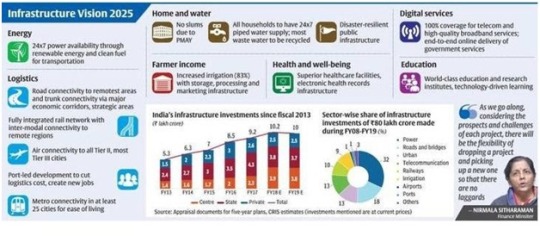
While most of the institutional support services and incentives are provided by the Central Government, others are offered by the State Governments in varying degrees to attract investments and promote small industries with a view to enhance industrial-production and to generate employment in their respective States.
#hyderabad#iascoachingcentersinhyderabad#civilservicescoachingcentersinhyderabad#civilservicescoachinginhyderabad#ias coaching in hyderabad#pragnyaiasacademy#Bangalore#iascoachinginbangalore#civilservicescoachinginbangalore#bestiascoachingcentersinhyderabad#best civils coaching info#best ias coaching classes#best ias coaching in hyderabad#civilservices#civilservicescoachinginstitutesinhyderabad
0 notes
Link
The UN Security Council has unanimously adopted a resolution welcoming the recent deal between the US and the Taliban to bring lasting peace in war-torn Afghanistan and allow US troops to return home from America's longest war.
The UN Security Council has unanimously adopted a resolution welcoming the recent deal between the US and the Taliban to bring lasting peace in war-torn Afghanistan and allow US troops to return home from America's longest war.
The US-Taliban peace deal was signed in Doha on February 29.
All 15 members of the UNSC on Tuesday supported the resolution, tabled by the United States, which endorses the joint US-Afghan declaration on peace and the agreement signed between Washington and the Taliban.
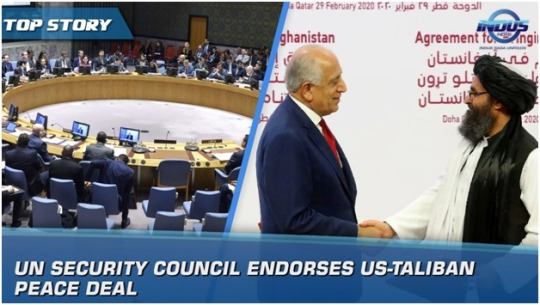
"The developments endorsed by this resolution are the product of more than a year of unprecedented US diplomatic engagement with the Taliban, in coordination with our partners in Afghanistan, the region, and around the world," Acting Deputy Permanent Representative of the US to UN Cherith Norman Chalet said.
The agreement with the Taliban calls for the fundamentalists to severe ties with international terrorist groups and to prevent them from using Afghanistan to carry out attacks against the US.
Under the terms of the deal, the Taliban would also participate in an intra-Afghan dialogue. While negotiations were scheduled to begin on Tuesday, they were postponed due to renewed violence and political discord at the highest levels of the government.
Afghanistan's rival leaders -- incumbent President Ashraf Ghani and his former unity government partner Abdullah Abdullah -- claimed victory in the presidential election held last September and each sworn in as the country's new president in separate ceremonies on Monday, throwing plans for talks with the Taliban into chaos
The US has welcomed President Ghani's steps towards agreement on an inclusive government, and Abdullah's commitments to peace and inclusivity.
#hyderabad#iascoachingcentersinhyderabad#civilservicescoachingcentersinhyderabad#ias coaching in hyderabad#civilservicescoachinginhyderabad#pragnyaiasacademy#civilservices#civilservicescoachinginstitutesinhyderabad#best ias coaching classes#best ias coaching in hyderabad#bestiascoachingcentersinhyderabad#best civils coaching info#civilservicescoachinginbangalore#Bangalore#iascoachinginbangalore
0 notes
Link
On the concept of blockchain-powered satellites, Aharsh MS, Chief Marketing Officer, Accubits, tells YourStory, “Chainsat will serve two purposes. One, it will act as one of the nodes of a private blockchain network or consortium blockchain. Second, it will enable a communication channel between different nodes of the blockchain network.”
The startup aims to send a low earth orbit satellite, weighing 12 kg, to space for establishing an enterprise blockchain ledger that can enable a secure transactional network for next-generation financial and IoT systems. It wishes to send it to the orbit by Q1 2021.
Besides, the startup will develop the software and firmware for the satellite while the hardware part will be collaboratively built by Accubits and a vendor. For this, the startup is in talks with multiple firms for collaboration.
One-of-its-kind solution :
Not all businesses are established in well-connected areas like Tier-I or Tier-II cities, but are set up across Tier-III cities. Today, companies have sprung in remote areas as well with dire connectivity issues.
Here, Chainsat will enable a secure communication channel for enterprises to use a blockchain network. According to Aharsh, Chainsat will enable businesses across the world to meet the specific requirements, as it acts as a blockchain node, or a point of contact for the enterprises.
For instance, for agro-related businesses, the production farms are remotely located and most of these places do not have internet accessibility. Here, Chainsat can help in establishing communication to access a blockchain ledger for applications like supply chain traceability and other crucial operations.
Besides, the satellites will be no different from the rest in the orbit in terms of its orbital presence, launch and operation. What differs is the software architecture and the internal hardware that is designed to host a blockchain node.
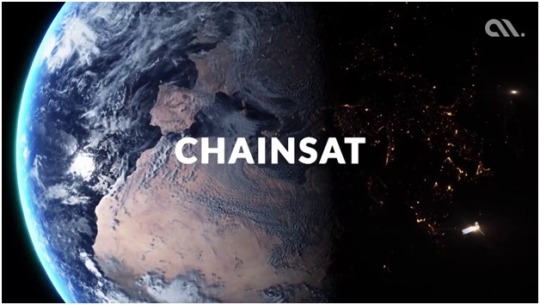
#hyderabad#civilservicescoachinginhyderabad#ias coaching in hyderabad#civilservicescoachingcentersinhyderabad#iascoachingcentersinhyderabad#pragnyaiasacademy#Bangalore#civilservicescoachinginbangalore#iascoachinginbangalore#bestiascoachingcentersinhyderabad#best civils coaching info#best ias coaching classes#best ias coaching in hyderabad#civilservicescoachinginstitutesinhyderabad#civilservices
0 notes
Link
The latest data on global arms transfer by SIPRI shows that Indian arms imports have come down significantly (by 32%) since 2015, indicating that the ‘Make in India’ initiative is gaining ground but the country is still ranked as the world’s second biggest weapons buyers, just behind Saudi Arabia.
Interestingly, imports from the US have taken a huge dip in the past five years, with the data showing that Russia now accounts for 56% of arms supplies. In fact, the US no longer figures among the top three suppliers of arms to India. After Russia, Israel at 14% and France at 12% are the major sources of weapons for India.
Even though India has ordered systems like the Apache and Chinook helicopters and additional P8I maritime aircraft from the US, orders to Russia – from the S 400 anti-air system to additional T 90 Tanks & helicopters have been significantly higher. The recent $3 billion deal for Apache and MH 60 'Romeo' choppers has not been taken into account in the data set.
“The USA became the second-largest arms supplier to India in 2010–14 as the security relationship between the two countries developed into a strategic partnership. However, in 2015–19 India continued with its policy of supplier diversification, and imports of arms from the USA were 51% lower than in 2010–14,” the report says.
The silver lining for India, along with the 32% dip in imports has been the entry into the exporters list. At present, the exports shown are modest – they account for only 0.2% of the global arms market – but the start is significant. India’s biggest clients are Myanmar, which accounts for 46% of exports, Sri Lanka at 25% and Mauritius at 14%.
As reported by ET, India has a target to increase its defence exports to $ 5 billion within five years. Defence Minister Rajnath Singh also shared at the ET Global Business Summit that the government will be extending additional Lines of Credit and grants for friendly foreign countries over the next five years.
The SIPRI data also shows the Pakistan has not become completely dependent on China for its weapon systems. Since 2015, China accounts for 73% of arms imports by Pakistan.
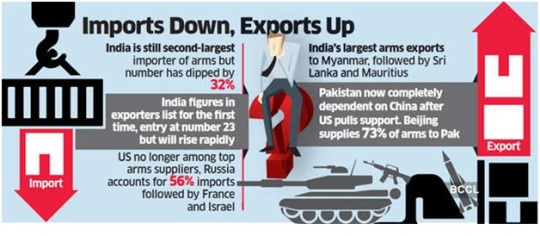
#hyderabad#civilservicescoachinginhyderabad#ias coaching in hyderabad#civilservicescoachingcentersinhyderabad#iascoachingcentersinhyderabad#pragnyaiasacademy#Bangalore#iascoachinginbangalore#civilservicescoachinginbangalore#civilservicescoachinginstitutesinhyderabad#best ias coaching in hyderabad#best ias coaching classes#best civils coaching info#bestiascoachingcentersinhyderabad
0 notes